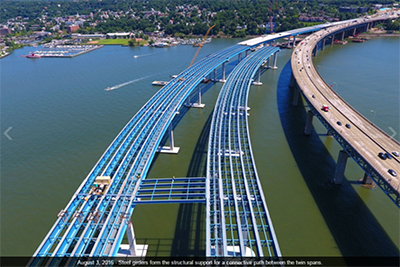
2017 Year in Review: Key Takeaways for Accelerating Project Delivery
and Improving Environmental Outcomes
In 2017, transportation agencies nationwide made significant strides toward accelerating project delivery while also focusing on improving environmental outcomes. Agencies embraced collaboration and innovative approaches to the transportation planning process, resulting in accelerated projects that meet communities’ needs. From highlighting exemplary practices such as Maine’s Programmatic Agreement (PA) on Atlantic Salmon and Arizona’s use of the Infrastructure Voluntary Evaluation Sustainability Tool (INVEST), to communicating the essentials of key environmental review processes such as bridge permitting and Endangered Species Act (ESA) consultations, each issue of Successes in Stewardship has distilled fundamental knowledge and best practices for transportation and environmental practitioners to incorporate into their agency’s work processes. This issue compiles the most important takeaways from each issue in 2017, focusing on the tools and key knowledge to enhance and accelerate the environmental review process.
Back to the Basics: Key Knowledge of Environmental Review Processes

The Tappan Zee Bridge in New York under construction. This project is an example of how integrating
NEPA
and permitting can successfully accelerate project delivery while meeting complex permit requirements.
(Image courtesy of the New NY Bridge).
Successes in Stewardship now includes a quarterly series called Back to the Basics that is published in January, April, July, and October. The purpose of this series is to provide readers with an in-depth understanding of a specific topic that is fundamental to working on projects, policies, or plans at the intersection of the environment and transportation. In 2017, Back to the Basics featured information on Section 106 compliance, improving the quality of environmental documentation, bridge permitting, and ESA Section 7 consultations.
Comprehensive knowledge of key topics and processes relevant to the project delivery and environmental review process ensures that delays are minimized and the best possible outcomes are achieved. In addition to the Back to the Basics subseries, the Federal Highway Administration (FHWA) Office of Project Development and Environmental Review offers resources, such as the Environmental Review Toolkit, to build capacity of environmental and transportation practitioners.
Tools and Mechanisms to Increase Efficiencies in Project Delivery
Throughout all of the past year’s issues of Successes in Stewardship, several similar approaches emerged that have been promoted by FHWA and used by State and local transportation agencies to successfully accelerate project delivery and improve environmental outcomes. Transportation agencies used the approaches in different ways, both independently and together as complementary processes, to achieve improved results.
Synchronize Schedules by Integrating NEPA and Permitting
Several challenges can arise during environmental review and permitting of transportation projects, leading to project delays or halting projects altogether. Integrating the National Environmental Policy Act (NEPA) and permitting processes allows the various environmental reviews and permitting procedures to be performed concurrently, providing more effective and efficient reviews. The February 2017 issue highlighted the “Integrating NEPA and Permitting” approach from the fourth round of Every Day Counts (EDC) to help Federal, State, and local transportation agencies navigate project delays associated with the environmental review and permitting process. This approach uses a number of integration techniques, including:
- Promoting process synchronization through the coordination of plans and schedules;
- Developing programmatic approaches;
- Establishing a dedicated liaison who will serve as a point of contact within resource and regulatory agencies;
- Facilitating early and frequent interagency coordination;
- Utilizing existing communication networks; and
- Revisiting existing integration practices to improve efficiency.
Several resources exist to implement these integration approaches. One such resource, the Federal Permitting Dashboard (Dashboard), is an online tool for Federal agencies, project developers, and the public to track the Federal government’s permitting and review process for large and complex infrastructure projects. The primary objectives of the Dashboard are to increase transparency and to shorten review timelines while improving environmental and community outcomes by encouraging early coordination and synchronization of agency review schedules. The March 2017 issue highlighted two legacy projects on the Dashboard that offer important lessons learned on how to successfully accelerate project delivery, the Pensacola Bay Bridge and the Tappan Zee Bridge.
By following the techniques outlined in “Integrating NEPA and Permitting” and utilizing the abundance of information on the Dashboard, agencies can increase efficiency, shorten delivery times, and save resources.
Utilize Programmatic Approaches
Many frequent and recurring transportation activities generally follow the same procedures and share similar levels of impact across similar ecosystems and regions. Programmatic approaches encompass a suite of techniques that allow transportation and regulatory agencies to eliminate the need to address the same issues repetitively on individual projects, accelerating routine environmental reviews. Efficiency is increased by considering repeated actions at a program level rather than by individual projects, and appropriate consideration for the resource is maintained. Programmatic approaches can result in more predictability and greater conservation success.
FHWA has extensively promoted programmatic approaches through initiatives such as EDC and other regular environmental program implementation, like Eco-Logical and Expediting Project Delivery. The May 2017 issue documented how the Maine Department of Transportation (MaineDOT) collaborated with FHWA and other agencies to develop a programmatic approach to consultation on species and habitats protected under the ESA and Magnuson-Stevens Fishery Conservation and Management Act. This programmatic approach was designed to reduce project delays due to a backlog of consultations with the U.S. Fish and Wildlife Service. A Programmatic Biological Opinion was issued in January 2017 and as a result, project approval time has been reduced by 75 percent.

ADOT’s PD scoring first focused on roundabout projects, such as this one.
(Image courtesy of ADOT)
Additionally, the January 2017 issue emphasized how Statewide Section 106 PAs, another example of a programmatic approach, can improve decisionmaking and advance environmental outcomes while accelerating project delivery. Section 106 PAs provide the authority to administratively delegate some responsibility for Section 106 to a State DOT, provide expedited timeframes in specified situations, and identify activities that have little or no potential to affect historic properties.
Emphasize Resiliency
Increasingly, transportation projects are expected to address more than just the mobility and accessibility needs of communities, but also include environmental, social, and economic components. Because of this, transportation agencies are starting to programmatically incorporate the principles of resiliency into their programs and projects, resulting in increased collaboration, better environmental outcomes, and improved quality of life for surrounding communities. The September 2017 issue and the November 2017 issue highlight two agencies that effectively emphasized resiliency to achieve positive results.
Because of its unique landscapes and nationally significant environments, the Arizona Department of Transportation (ADOT) recognizes the critical need to consider resiliency in their efforts to expand, operate, and maintain their transportation network. Using FHWA’s INVEST, ADOT has scored over 50 individual transportation projects and developed recommendations for improvements to agency practices based on those evaluations; integrated recommendations and resiliency concepts into ADOT manuals and guidance; conducted trainings with internal ADOT departments and external stakeholders; and developed an award program to recognize ADOT projects and projects managers that go above and beyond, as measured by the INVEST score, best management practices, and collaboration. ADOT continues to push the limits of environmental practices by incorporating resiliency measures into traditional prioritization models and into Alternative Selection Reports of Environmental Analyses and Environmental Impact Statements.
The November 2017 issue provided details on another project that is achieving success by emphasizing resiliency. Following decades without significant improvements along the North Coast Corridor (NCC), the California Department of Transportation (Caltrans), the San Diego Association of Governments, and other regional stakeholders developed a 40-year, $6 billion program to improve the quality of life for residents, promote regional economic growth, and protect and enhance the coastal environment of the Greater San Diego area. Caltrans used the Envision tool, an online rating system for infrastructure projects that provides guidance and best practices to minimize each project’s impact on the surrounding community and environment. Projects include the establishment of a value pricing high-occupancy toll lane along I-5 from La Jolla to Oceanside; nearly 30 miles of coastal bicycle and pedestrian paths; rail corridor upgrades; and habitat-related environmental mitigation activities, including habitat acquisition, land management, scientific research, and environmental restoration. The NCC Program shows that by incorporating environmental considerations into infrastructure investments, Federal, State, and local agencies can meet the demands of burgeoning communities and the unique natural environment that surrounds them.
Recognizing Exemplary Practices that Achieve Environmental Excellence
Throughout 2017, Successes in Stewardship highlighted numerous best practices from projects and processes that transportation agencies can use to improve their own project outcomes. The August 2017 issue focused on three projects that were among the 18 winners of the 2017 Environmental Excellence Awards (EEAs). The EEAs recognize projects from across the country that go beyond environmental compliance to achieve environmental excellence. These projects not only meet environmental requirements such as those in NEPA and the National Historic Preservation Act, but they also excel in advancing innovations and best practices that protect and enhance the natural and human environment and help accelerate project delivery.
The takeaways and essential knowledge provided in each issue of Successes in Stewardship can be applied by transportation agencies to improve future projects and work processes. Emphasizing resiliency, integrating NEPA and permitting, and establishing PAs are just a few of the many mechanisms available to accelerate project delivery and improve environmental outcomes. FHWA looks forward to sharing future advancements in environmental review and project delivery in the coming issues of Successes in Stewardship.
Contact Information
Stephanie Stoermer
Environmental Program Specialist
FHWA Resource Center
(303) 594-8556
Stephanie.Stoermer@dot.gov
Damaris Santiago
Project Mitigation Team Leader
FHWA Office of Project Development and Environmental Review
(202) 366-2034
Damaris.Santiago@dot.gov
Look What’s New!
- Stay tuned for more issues of Successes in Stewardship in 2018 that continue to highlight best practices in environmental review and project delivery and offer useful insights for practitioners in the field.
Successes in Stewardship is a Federal Highway Administration newsletter highlighting current environmental streamlining and stewardship practices from around the country. Click here to subscribe, or call (617) 494-2013 for more information.

